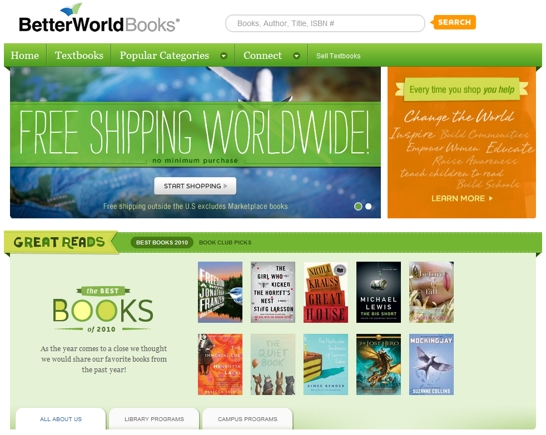Merchants have almost 600 online shopping carts to choose from, including hosted carts, licensed carts and open-sourced carts. Each week in “Cart Talk” we interview a merchant that uses a particular cart, to get frank, real-world feedback on its use – what works and what needs improvement.
This week, we’ll hear from John Ujda, vice president of marketing at BetterWorldBooks.com, a Mishawaka, Ind.-based new and used book retailer, where each book sold generates funds to literacy initiatives in the U.S. and around the world.
BetterWorldBooks.com uses an in-house developed shopping cart built on Microsoft’s ASP.net, which is a web framework.
Ujda says this about cost of use, “For us, the cost of the cart exists only in the developer time invested in creating it. At the time it was built, in 2006, we had 1 or 2 salaried developers on staff, full-time. And when we overhauled it in 2009 we invested in 2 more developers for approximately 3 months.”
BetterWorldBooks.com is a large retailer that that processes 7,000 orders per month online. Since its inception in 2003, the company says it has raised over $8.5 million for its non-profit literacy, library and college partners; donated over 3.3 million books; and re-used or recycled more than 46 million pounds of books. In 2010, Better World Books’ gross annual revenue was $45.4 million.

BetterWorldBooks.com home page.
Practical eCommerce: Why a custom cart based on ASP.net?
John Ujda: “We started the site using Able Commerce, an ASP.net designed cart, in 2006 and quickly began modifying and adding onto it. Able was designed for smaller web stores, so as we’ve grown over time we’ve removed functions from Able and built them ourselves.
“This past year we finally migrated completely off of Able to our home grown ASP.net platform (our entire website is built on Microsoft ASP.net, a robust platform for building dynamic websites). This technology meets our needs of housing a shopping cart and processing orders with no licensing fees beyond ASP.net on which the site is built. It also permits us a lot of flexibility when we want to customize things. Because we evolved from an off-the-shelf technology to customization of that off-the-shelf product to finally being purely home-grown, we never looked at other shopping cart offerings.”
PeC: Can you describe how a customer completes an order in your ASP.net cart, step-by-step?
Ujda: “We reorganized our ordering process in 2009. Previously, we had a five-step process that required account creation, a login and had key elements like a user’s ‘address selection,’ in locations on the screen that were not intuitive.
“Now, we have a process that takes consumers only two page-loads to complete a purchase and doesn’t require registration. We stripped off all the exit paths from the checkout process, except a simple link back to the shopping cart. (Isn’t that annoying when you can’t get out except by the browser back button?). And these changes led to a significant improvement in our sell-through rates.
“The first page of that two-step process is our ‘shipping information page.’ At the top we ask for a consumer’s email address and if that consumer already has an account he or she can simply login at that point. As I said, we do not require registration — we feel it that is a barrier to completing the purchase. So, instead we tucked it at the end – I’ll get to more on that below. Then, below the entered email address, the consumer enters a shipping address. If a consumer has purchased with us previously, a default address is pre-selected or the user can select from the several addresses he or she has shipped to at this point.
“Additionally, on this first page the consumer can opt to make a payment of $0.03 to $0.05 to offset the carbon emissions required to ship their books.
“The second page of the process is the ‘billing information page.’ The consumer selects a credit card, PayPal or a gift certificate as their payment method. The payment information section dynamically changes based on the consumer’s selection. This is so the consumer is only asked for the information required for whichever specific payment method selected. At the bottom of this page is a button to complete the purchase.
“During both steps, running down the right rail of the site, we maintain an order summary showing their sub-total, shipping, carbon offsets, and tax – with a cost total in at the top and cart contents listing at the bottom. Consumers can also enter a coupon code at anytime into the coupon entry field during either step of the billing information page.
“After the user has hit the button to complete his or her purchase, the ‘thank you’ page loads and a JavaScript lightbox window appears over that ‘thank you’ page requesting the consumer create a password to establish the account. This way we still get accounts created without impeding the sale. The consumer can also opt out of account creation at this point. Requiring users to create an account makes them feel like they are giving up some aspect of their privacy, and for small purchases it feels very unnecessary. As a result, when registration is required up-front, some people just walk away rather than buying that $3.98 paperback; it’s just not worth the trade-off to them.
“Once the consumer has either entered a password or opted out, they are left on the ‘thank you’ page which has a link to print a receipt and which also encourages them to follow us on social media sites.”
PeC: What are the cart’s biggest strengths?

John Ujda
Ujda: “The strengths of our cart experience revolve around minimizing and removing barriers to completing the sale. We ask for the bare minimum information needed to complete the order and we keep it simple.
“When it comes to the platform of our cart, the biggest strengths are the flexibility to customize it (since we built it), and not having to pay licensing fees to run it (again, since we built it).”
PeC: How could the cart improve?
Ujda: “We actually need to improve our shipping page so that consumers can select different shipping methods for books coming from different sources. We host a marketplace of other sellers on the site and currently, when one of those sellers’ books is in a consumer’s cart, we have to reduce the shipping options available, since we don’t ship those books.
“For example, if a consumer has only books shipped from Better World Books, he or she has what we call the ‘Expidoodle’ option available (our proprietary 2-6 day shipping at $0.99/book). Whereas, if one marketplace book is in that same cart, the consumer loses that ‘Expidoodle’ option and can only select one shipping method because marketplace sellers can’t ship using our proprietary method. We’d like to enable consumers the ability to select one shipping method/address for books shipped from Better World Books, and another shipping method/address for books that come from another marketplace provider.
“We also need to start merchandising effectively in the shopping cart itself (not in the checkout process). We don’t make recommendations in the cart today, and that is an obvious and significant opportunity for us.
“When it comes to the platform, we need to introduce some robust A/B testing capabilities. A/B is the process of splitting your users across two versions of the experience: version A being what is currently in use and version B being some variation on version A. If version B ends up with better sell-through, then you adopt it for everyone and introduce version C to compete with version B, and so on. We are always testing and learning what leads to higher conversion rates.
“I don’t for a second believe what we have is the best it can be, and I know from experience that what works with consumers can be unpredictable and/or counterintuitive. So we need to start doing more testing to continuously optimize the checkout.”
PeC: Do you plan on continuing to use the cart?
Ujda: “Yes.”
PeC: Any other thoughts for our readers concerning choosing a shopping cart?
Ujda: “Test paid third party trust marks against your own trust marks before you spend a lot of money on them. When our trust mark provider raised rates, we A/B tested it with and without their trust mark and found that it more than paid for the higher rates. But, then we said, ‘wait a minute, we just ran the wrong test. What we need to test is the branded trust mark against a generic trust mark that we create.’ When we ran that test we found no difference in performance. Will that hold true for others? The only way to know is to test for yourself. Every site and its consumers are different and you can’t know what works until you test.”
Observations from a Shopping Cart Expert
In “Cart Talk,” we ask a shopping cart expert to analyze the cart in question and the merchant’s use of it, offering up some constructive advice in the process. This week, we spoke to our own senior contributing editor, Armando Roggio, about the BetterWorldBooks ASP.net cart. In addition to his work for Practical eCommerce, Roggio is site director for Ecommerce Developer, our companion site for web developers. He’s also an ecommerce merchant and an independent developer.
Armando Roggio: “This is a custom cart, so by definition I have not been able to look too far under the hood or poke around in the source. But it generally looks like a very well done bit of work.
“In my opinion, it is a huge undertaking to build a custom ecommerce platform from scratch and that undertaking usually does not work out or payoff in the long run. But in this particular case, Better World Books has a great looking, functional site that is clearly working for their business — so, bravo.
“If they don’t have it already, I would recommend that they obtain lots of great documentation regarding the custom development of the cart so that if one of their developers decides to retire they are not left scratching their collective heads trying to figure out how the site is architected.
“One small point for improvement: the platform could do a better job from a performance standpoint. It scored a ‘D’ on a YSlow test run in Firefox 3.6. So, in addition to the improved shipping options, it might be a good idea to streamline some of the code. For example, it may be possible to combine the site’s 18 external JavaScript files and thereby make fewer HTTP requests.
“Overall, it sounds like it is an excellent choice for Better World Books. Their online store is very professional, functional, and—based on their order volume and marketplace—effective.





